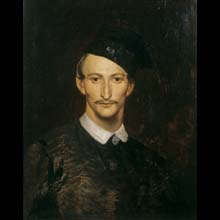
material: oil on canvas
dimensions: 73 x 59 cm
description: The outbreak of the January Uprising found Grottger in Vienna. The artist wanted to get to the Kingdom of Poland to take part in the fight, and he reluctantly abandoned his intention after the persuasion of his friends worrying about his delicate health. Nevertheless, he contributed to the struggle in a different way, for example, by participating in the purchase of weapons for the insurgents. The work Self-Portrait in a Four-Cornered Hat is a manifestation of the artist’s patriotic commitment and support for the uprising. It shows a young, extremely slim man in bust-length, en face. The painting is characterized by modest, almost austere treatment of the sitter, intimate, slightly melancholic mood, a dark, narrow tonal range and a sketchy technique, especially pronounced in the handling of the attire and the background. The portrait effectively conveys the characteristic physiognomy of the artist. Grottger’s modest clothes accentuate his patriotic attitude. The artist is wearing a white shirt and a dark tunic fastened at the neck resembling the “czamara,” a men’s long-sleeved fitted outer garment, worn by Polish gentry. His attire is complemented by a cloth four-cornered hat, set at an angle, called “konfederatka” from the time of the Confederacy of Bar. The “czamara” and the “konfederatka,” treated as a kind of uniform by the January insurgents, were the symbolic elements of the Polish patriotic costume in the 19th century. Aleksandra Krypczyk
exposition: The Gallery of 19th Century Polish Art in Sukiennice,
The Cloth Hall, 1, Main Market Square
key: Romanticism. Towards national art >>>
dimensions: 73 x 59 cm
description: The outbreak of the January Uprising found Grottger in Vienna. The artist wanted to get to the Kingdom of Poland to take part in the fight, and he reluctantly abandoned his intention after the persuasion of his friends worrying about his delicate health. Nevertheless, he contributed to the struggle in a different way, for example, by participating in the purchase of weapons for the insurgents. The work Self-Portrait in a Four-Cornered Hat is a manifestation of the artist’s patriotic commitment and support for the uprising. It shows a young, extremely slim man in bust-length, en face. The painting is characterized by modest, almost austere treatment of the sitter, intimate, slightly melancholic mood, a dark, narrow tonal range and a sketchy technique, especially pronounced in the handling of the attire and the background. The portrait effectively conveys the characteristic physiognomy of the artist. Grottger’s modest clothes accentuate his patriotic attitude. The artist is wearing a white shirt and a dark tunic fastened at the neck resembling the “czamara,” a men’s long-sleeved fitted outer garment, worn by Polish gentry. His attire is complemented by a cloth four-cornered hat, set at an angle, called “konfederatka” from the time of the Confederacy of Bar. The “czamara” and the “konfederatka,” treated as a kind of uniform by the January insurgents, were the symbolic elements of the Polish patriotic costume in the 19th century. Aleksandra Krypczyk
exposition: The Gallery of 19th Century Polish Art in Sukiennice,
The Cloth Hall, 1, Main Market Square
key: Romanticism. Towards national art >>>












